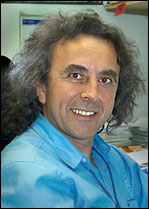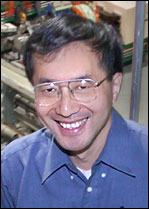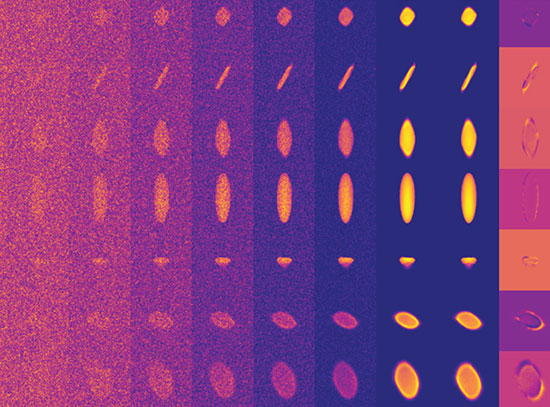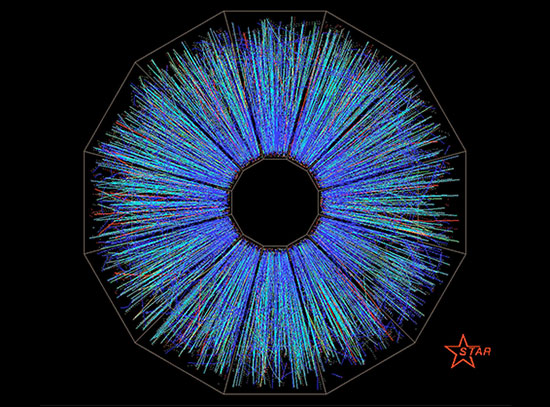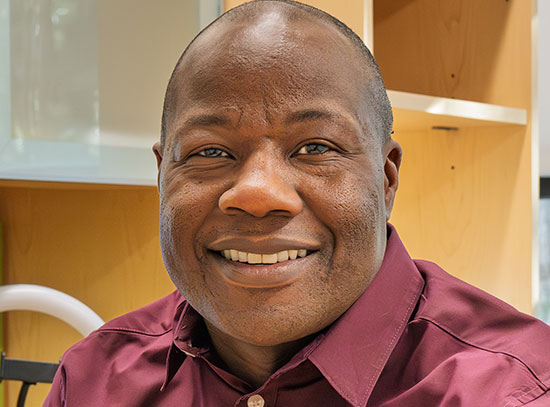Two Brookhaven Lab Physicists Named American Physical Society Fellows
June 28, 2004
Upton, NY - Vladimir Litvinenko and Jie Wei, physicists at the U.S. Department of Energy_s Brookhaven National Laboratory, were elected Fellows of the American Physical Society (APS). With over 43,000 members, APS promotes the advancement and diffusion of the knowledge of physics in the belief that an understanding of the nature of the physical universe will be of benefit to all humanity. Each year, no more than one-half percent of the society_s membership are recognized by their peers for election to the status of Fellow. Litvinenko and Wei were among a total of 215 new Fellows elected in 2003.
Vladimir Litvinenko_s Fellowship citation reads: "For fundamental and pioneering contributions to the physics of beams in electron storage rings and free electron lasers, including demonstrating the optical klystron and advancing the short wavelength limit of FEL [free electron laser] oscillators."
An FEL is a research tool that combines the focus of lasers and the intensity of synchrotrons, and it is useful in studying a wide variety of materials and chemical interactions. Litvinenko and his team built a number of FELs based on the design of an optical klystron, an advanced version of an FEL. In 1988 and 1999, their team was the first in the world to extend the range of an FEL to the ultraviolet wavelength and to the vacuum ultraviolet, respectively. This work makes possible a wider variety of experiments in numerous scientific fields.
Currently, Litvinenko is deputy group leader of the electron-cooling project for the Relativistic Heavy Ion Collider (RHIC), Brookhaven_s newest accelerator. The goal of this project is to increase RHIC_s luminosity, which would result in more productive particle collisions, and, thus, more data collected in a shorter time. "With the increased luminosity, we will collect five to ten years of data from RHIC in one year," Litvinenko said.
Litvinenko earned his bachelor_s and master_s degrees in physics from Novosibirsk State University, Russia, in 1975 and 1977, respectively, and he earned a doctoral degree in physics and mathematics from the Institute for Nuclear Physics, Russia, in 1989. After working on free electron lasers at the Institute for Nuclear Physics from 1973 to 1991, Litvinenko became a faculty member at Duke University in 1991. A frequent guest researcher at Brookhaven Lab, Litvinenko joined Brookhaven as a senior physicist in 2003. He also became an adjunct professor at Stony Brook University last year.
Litvinenko has received numerous awards, including the UV FEL Research Award from the Science and Technology Agency in Japan in 1997; two FEL Research Awards from the Ministere de la Recherche et de la Technologie, France, in 1991 and 1993, as well as two awards from the Russian Academy of Science in 1977 and 1989.
Jie Wei_s citation reads: "For his outstanding and creative contributions to the design and development of RHIC and SNS [Spallation Neutron Source]."
Wei started working on the design of RHIC in 1986, when he was a graduate student in physics at Stony Brook University. He joined Brookhaven as a research associate in 1989, and continued to work on various topics in accelerator physics - such as transition energy crossing, intra-beam scattering and stochastic cooling - related to keeping the beams of gold ions in RHIC stable and on course. At RHIC, physicists are gaining insight into the nature of matter as it existed just after the Big Bang.
When RHIC_s construction started in 1991, Wei was part of a team of physicists and engineers who analyzed each of the 1,740 superconducting magnets in the accelerator to be sure they were built and functioned according to specifications. Wei placed correction magnets in strategic locations in the collider so that RHIC_s luminosity could be improved in the future.
Since 1998, Wei has been working on the Spallation Neutron Source (SNS), a $1.4 billion accelerator-based neutron source being built at Oak Ridge National Laboratory in Tennessee. Wei was responsible for the accelerator physics integration and coordination of the SNS project that has been assigned to six U.S. Department of Energy national laboratories: Argonne, Brookhaven, Lawrence Berkeley, Los Alamos, Oak Ridge and Thomas Jefferson National Accelerator Facility. Wei is currently the senior team leader responsible for the design and construction of the SNS accumulator ring and transport lines. When the SNS is complete in 2006, it will provide the world_s most intense pulsed neutron beams for scientific research and industrial development.
Wei earned a bachelor_s degree in physics from Tsinghua University in Beijing, China, in 1983, and a Ph.D. from Stony Brook University, in 1989. He joined Brookhaven Lab in 1989 as a research associate, and he was named physicist in 1995. In 2000, he became a research and development manager in the Laboratory_s Collider-Accelerator Department, the position he now holds.
2004-10194 | INT/EXT | Newsroom




